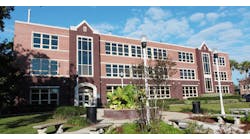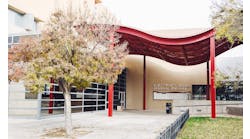Concerned about energy costs? It's a worthy concern. Heating and cooling costs represent up to 60 percent of a typical building's operating budget. This makes energy efficiency a high priority. Unfortunately, achieving energy efficiency in new construction is not a standard procedure. If anything, it's a constantly changing science.
This much is known: Optimizing energy efficiency is a multi-component, integrated process; it's not the result of a single technique or product. Although some aspects are unique to specific regions and buildings, certain elements are consistent when the objective is heating and cooling efficiency:
-
Adding insulation where needed to create an effective thermal (building) envelope.
-
Selecting the right heating, ventilation and air-conditioning system for the facility's size, location and function.
-
Selecting window sizes and glass types that minimize heat transfer.
-
Choosing a building shell that helps reduce air leakage.
-
Monitoring and adjusting thermostat settings to coincide with usage.
-
Scheduling routine maintenance on the building and its heating/cooling equipment.
An inadequate building envelope is a leading cause of unnecessary energy use. A building's envelope is composed of walls, windows, doors, a foundation and a roof. Installing the right amount of insulation keeps an envelope strong and reduces energy expenses.
Accurate facility planning requires understanding how to calculate insulation value and compare the insulation efficiencies of various building materials.
Calculating insulation effectiveness
A material's R-value measures its resistance to heat flow. It's the most common term used to represent how easily insulation materials transfer heat. A high R-value means that the material is better at resisting heat and functioning as an insulation material.
When measuring wall system R-values in various parts of a building, remember a sector's R-value is only as good as its least-efficient component. For example, if a building uses high-performance windows (such as double-paned glass with low-emissivity coating) designed to reduce heat flow, but has insufficient wall panel insulation, the R-value will reflect the lower efficiency of the panels, not the highly efficient windows.
The most accurate method of calculating R-values for wall systems is to add the R-values of all the panel materials, subtract the value of heat loss from thermal breaks, and then add the effects of thermal mass (if any).
For example: For a wall panel comprising a 3-inch layer of concrete, a 2-inch layer of foam, and another 3-inch layer of concrete, the first number (in the equation above) is the combined R-value of all the materials.
The second number in the calculation, heat loss from thermal breaks, is determined by identifying and accounting for areas that violate the insulation area and greatly reduce energy efficiency. In wall panels, thermal breaks can range from the obvious, such as doors and windows, to structural ribs embedded in the wall that are invisible to the eye and highly conductive.
The third number, the effects of thermal mass, relates to the laws of physics in which heat, like other forms of energy, follows the path of least resistance. Heat naturally flows from warm areas to colder areas and, in real-life situations, inside and outside temperatures are not always constant. The force behind conductive heat flow between the exterior and interior of a wall can change significantly and even reverse during the day.
For example, an exterior wall that is dark in color and in the sun will be significantly hotter than the actual outside temperature. When the inside temperature is cooler than the outside reading, heat conducts inward from the outside surface of the wall. Then, as the outside temperature falls at night, the driving force for heat flow reverses. Energy, as heat, is drawn from the inside to the outside of the building through conductive heat transfer.
In materials with high thermal mass, the heat-transfer process is delayed and even blocked by the high heat-retention capacity of the wall mass. This “thermal mass effect” has a quantifiable impact on the energy efficiency of a wall that cannot be determined by R-value alone.
Comparing building materials
The R-value of building materials depends on the material type, thickness and density. Porous materials, such as masonry and wood, are at the less-efficient end of the R-value spectrum. They require insulation to simply meet the code minimum. Metal, although it's not porous, does not perform much better. Similar to single-pane glass, metal is known for high heat conductivity (and reduced energy efficiency). Also, the extensive studwork typically used in metal walls creates natural passageways for air, which has a negative effect on energy efficiency. When an exterior skin of thin metal paneling covers a metal frame, each screw and cut edge is a miniature point of failure for air penetration.
Concrete, by comparison, is a high-capacity material with strong heat-retention capabilities, which allows it to take advantage of the mass effect phenomenon. Among the numerous concrete panels available, non-composite precast concrete wall panels offer more insulating value than composite wall designs.
Understanding the limitations of a composite wall panel is key to realizing the benefits of a non-composite wall. Composite wall panels combine two separate layers of concrete with steel ties and solid areas of concrete to create one “composite” panel. An independent study examined the thermal efficiency of the composite panel method and found that 5 percent solid concrete and steel ties resulted in a 60 percent loss of the claimed heat-flow resistance (or R-value) of 10.14, which reduced the actual R-value to just 4.13. This decrease, the study found, is due mainly to the presence of thermal breaks.
Non-composite concrete panels avoid such decreases because they combine a unique structural core, a rigid insulation layer and a nonstructural facade for exceptional strength without the need for a thermal bridge. Eliminating highly conductive thermal breaks increases energy efficiency.
Raising the standard
Advances in manufacturing technology offer schools lower heating and cooling costs, improved safety and increased design flexibility with new foam core precast panels. The advance in precast manufacturing means several more expensive methods of increasing R-values might no longer be necessary. A builder, for example, might select hollow-core panels over insulated products because of the lower initial cost. Then, to achieve the required level of insulation, the builder will hire an additional contractor to fill the hollow core panels, on the job site, with liquid foam. The ability to add the insulating value of EPS at the plant — without a price increase — eliminates a step that added 32 cents per square foot to the project cost.
Kuckhahn is director of engineering for Fabcon Inc. The company manufactures and erects precast concrete wall panels, and has manufacturing plants in Minnesota, Indiana, Ohio and Pennsylvania.

